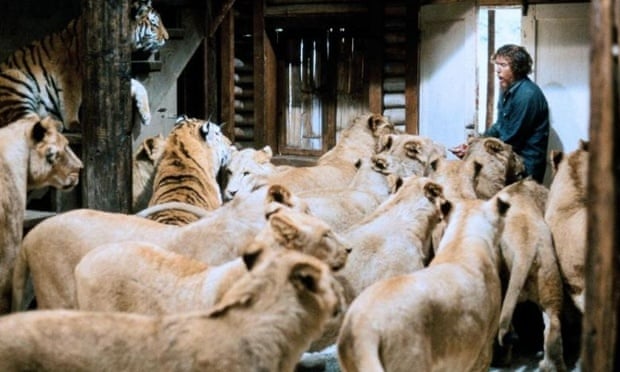Tippi Hedren’s leg was broken, Melanie Griffith required facial
reconstructive surgery, the director got gangrene and the
cinematographer needed 200 stitches on his scalp. To see this 1981 lion
drama - on limited release this Friday – is to become a dog person

One symptom of our terrible, horrible, no good cinematic age: death-defying stunts in movies are pretty much par for the course, and thus unimpressive. A Chitauri spacecraft can smash through the windows of Grand Central Terminal and look fairly photoreal, yet it’s one of the least exciting bits in The Avengers’ third act slugfest. All our high falutin’ technology has done a lot to enhance the filmgoing experience, don’t get me wrong, but it has desensitised to the point that we expect danger at every turn.
We knew that young Suraj Sharma was never near a real uncaged tiger while shooting Life of Pi, which is why Drafthouse Films, the Austin-based upstart theatre chain and distributor of hard-to-categorised movies, is pushing the behind-the-scenes elements of their unearthed gem Roar as much as the film itself. It’s a smart move. There’s really not much going on with Roar storywise. But then you take a step back and think about what it is that you’re watching. My viewing of Roar was set to a soundtrack of “Oh my God!” and “Holy crap!”, all of my own making.
Roar, finished in 1981, was the pet project of Noel Marshall. He was a producer on The Exorcist and used his own, demon-bred money to finance this film that nearly killed him and his whole family. That family consisted of his wife Tippi Hedren, his two sons and Hedren’s daughter Melanie Griffith. The basic plot is that Marshall is working in as a zoologist in Africa. (And maybe he’s a doctor, too? There’s a shot of him in a white coat among Masai villagers. For a movie that took over 10 years to make, it is a tad incoherent.)
Anyway, Marshall’s family is coming to live with him after some time apart, now that he’s allegedly got his homestead settled. The compound consists of a whole mess o’ lions, tigers, pumas, you name it, romping around the interior of the house, on the porch, the little pier where visiting boats arrive. Some moustache-twirling poachers don’t like the idea of him protecting all these big cats, but Marshall defends it with aphorisms.
“The cats get a little excit---” Marshall tries to explain, but he can’t complete his sentence because an enormous lion pounces on him, knocking him to the ground. Later in the same sequence, you can see what clearly is not stage blood pouring from his hands.
Aside from a few moments with the would-be poachers and some family talk (more on this in a bit) the lion’s share of Roar is one outrageous full-frontal shot of Big Kitty Power after another. Lions shove young Melanie Griffith to the ground, a striped tiger capsizes a boat and, for those who tire of felines, there’s also an elephant that sends Tippi Hedren flying through the air.
It was the elephant that put Hedren in the hospital with a fractured leg. And she wasn’t the only one. Cinematographer (and future Speed director) Jan De Bont had half his scalp ripped off requiring over 200 stitches. Griffith also needed stitches to her face and plastic surgery around her eye. Marshall contracted gangrene at some point during the production. In total, there were 70 cast or crew injuries.
How in the hell did Marshall think this was a good idea? Well, he and Hedren had actually turned
their home into a shelter for big cats – and living with them – for years. (The preserve still exists, and Hedren still runs it. Marshall passed away in 2010, but he and Hedren divorced one year after Roar was finally completed. Neither she nor Griffith is doing any promotion for this re-release of the film.)
God only knows what life was like in the late 1970s in the Marshall household. The lengthiest scene of dialogue he gives Hedren and her stepdaughter (right in front of her stepbrothers) is an undeniably creepy back and forth about teen sexuality. It’s almost as startling as the image of a tiger bashing a barrel containing one of Marshall’s sons off a high deck into a pond.
While Roar is violent, it is not anti-big cat. There are numerous sequences of these marvellous creatures being peaceful and playful. You want to watch a lion teach himself how to ride a skateboard? This is the movie for you. The underlying principle, as any good naturalist will tell you, is that you have to respect wild animals and give them their space. Despite espousing this philosophy, this is something that Noel Marshall didn’t quite understand.
• Roar is on limited release in the US from 17 April
source
No comments:
Post a Comment